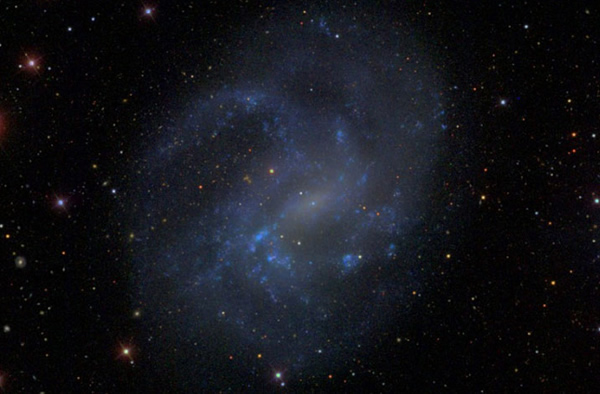Massive Black Holes are Everywhere!
Dwarf galaxy NGC 4395, previously thought incapable of having a central massive black hole, is one of approximately 100 dwarf galaxies to have such black holes after all.
Too often, the term “paradigm-shift” is used in science reporting for things that, really, aren’t much of a shift in our thinking at all. However, this week it was used to describe a new astronomical discovery, and for once I agree that this is a BIG DEAL.
The story is in the discovery of massive black holes in the centers of dwarf galaxies by Amy Reines of the National Radio Astronomy Observatory. Now, we are quite familiar with the story that all massive galaxies have supermassive black holes in their centers. In fact, the bigger the galaxy’s central bulge, the bigger the supermassive black hole, or SMBH. There seems to be a definite link between the evolution of galaxies and the evolution of their central black holes.
An outstanding question is: how do these supermassive black holes form? Many millions or billions of “regular” mass black holes would fit inside one SMBH, but its hard to imagine this ever happening realistically in the Universe. It is likely, however, that SMBHs started as simply Massive Black Holes (MBHs) during the early days of the Universe, either as gas clouds collapsed catastrophically or supermassive stars somehow formed massive seed black holes. These seed black holes are far too distant to observe with current capabilities though.
This is why astronomers are so excited to find an analog of these massive black holes in an unexpected place: dwarf galaxies. We already knew that all large galaxies, such as our Milky Way, harbor supermassive black holes in their centers, but the tiny dwarf galaxies that have no central bulge and tend to cluster around bigger galaxies didn’t appear to have such central black holes.
Then, a few years ago, Reines serendipitously discovered a massive black hole at the heart of dwarf galaxy Henize 2-10. This took her work in a whole new direction. Now, after having closely studying some 25,000 dwarf galaxies, she and her collaborators have found evidence for massive accreting black holes in 100 of them. These MBHs are not millions or billions of times the mass of the sun, but a few hundred thousand times the mass of the sun. These are very much like what the seeds of supermassive black holes may have been like in the early Universe, and they are close enough to study.
100 out of 25,000 doesn’t seem like a lot. However, these are only the ones that have material actively falling on to them. We know that about 10 percent of supermassive black holes are active, leaving the other 90 percent to be pretty quiet. We don’t know the percentage of active to quiet massive black holes in dwarf galaxies just yet, but it is likely that the 100 are just the tip of the iceberg. And so now we have many dwarf galaxies harboring central massive black holes as well as their larger counterparts, and that does indeed represent a paradigm-shift in what we know about black hole and galaxy evolution.
There is one more bonus to this story. The astronomers didn’t even have to take new data to make this amazing discovery. Instead, they analyzed spectra of galaxies that had already been taken with the huge Sloan Digital Sky Survey.
As astronomy moves into a era of more and more big telescopes and big surveys, it is crucial that these data be accessible so that any researcher can look back and find something we’d never thought we’d see without having to even use another telescope.
This work has been published in the Astrophysical Journal, and a preprint is available at arXiv.org.(Jan 8, 2014 01:46 PM ET // by Nicole Gugliucci)












